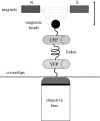Live cell imaging of mechanotransduction
- PMID: 20356874
- PMCID: PMC2943879
- DOI: 10.1098/rsif.2010.0042.focus
Live cell imaging of mechanotransduction
Abstract
Mechanical forces play important roles in the regulation of cellular functions, including polarization, migration and stem cell differentiation. Tremendous advancement in our understanding of mechanotransduction has been achieved with the recent development of imaging technologies and molecular biosensors. In particular, genetically encoded biosensors based on fluorescence resonance energy transfer (FRET) technology have been widely developed and applied in the field of mechanobiology. In this article, we will provide an overview of the recent progress of FRET application in mechanobiology, specifically mechanotransduction. We first introduce fluorescent proteins and FRET technology. We then discuss the mechanotransduction processes in different cells including stem cells, with a special emphasis on the important signalling molecules involved in mechanotransduction. Finally, we discuss methods that can allow the integration of simultaneous FRET imaging and mechanical stimulation to trigger signalling transduction. In summary, FRET technology has provided a powerful tool for the study of mechanotransduction to advance our systematic understanding of the molecular mechanisms by which cells respond to mechanical stimulation.
Figures




Similar articles
-
[Applications of FRET technology in the study of mechanotransduction].Sheng Wu Yi Xue Gong Cheng Xue Za Zhi. 2013 Dec;30(6):1362-7. Sheng Wu Yi Xue Gong Cheng Xue Za Zhi. 2013. PMID: 24645627 Review. Chinese.
-
FRET and mechanobiology.Integr Biol (Camb). 2009 Oct;1(10):565-73. doi: 10.1039/b913093b. Integr Biol (Camb). 2009. PMID: 20016756 Free PMC article. Review.
-
Application of FRET Biosensors in Mechanobiology and Mechanopharmacological Screening.Front Bioeng Biotechnol. 2020 Nov 9;8:595497. doi: 10.3389/fbioe.2020.595497. eCollection 2020. Front Bioeng Biotechnol. 2020. PMID: 33240867 Free PMC article. Review.
-
Fluorescence proteins, live-cell imaging, and mechanobiology: seeing is believing.Annu Rev Biomed Eng. 2008;10:1-38. doi: 10.1146/annurev.bioeng.010308.161731. Annu Rev Biomed Eng. 2008. PMID: 18647110 Review.
-
Unravelling molecular dynamics in living cells: Fluorescent protein biosensors for cell biology.J Microsc. 2025 May;298(2):123-184. doi: 10.1111/jmi.13270. Epub 2024 Feb 15. J Microsc. 2025. PMID: 38357769 Review.
Cited by
-
A Membrane-Bound Biosensor Visualizes Shear Stress-Induced Inhomogeneous Alteration of Cell Membrane Tension.iScience. 2018 Sep 28;7:180-190. doi: 10.1016/j.isci.2018.09.002. Epub 2018 Sep 8. iScience. 2018. PMID: 30267679 Free PMC article.
-
Mechanical Forces in Cutaneous Wound Healing: Emerging Therapies to Minimize Scar Formation.Adv Wound Care (New Rochelle). 2018 Feb 1;7(2):47-56. doi: 10.1089/wound.2016.0709. Adv Wound Care (New Rochelle). 2018. PMID: 29392093 Free PMC article. Review.
-
Extracellular Calcium Modulates Chondrogenic and Osteogenic Differentiation of Human Adipose-Derived Stem Cells: A Novel Approach for Osteochondral Tissue Engineering Using a Single Stem Cell Source.Tissue Eng Part A. 2015 Sep;21(17-18):2323-33. doi: 10.1089/ten.TEA.2014.0572. Epub 2015 Jul 13. Tissue Eng Part A. 2015. PMID: 26035347 Free PMC article.
-
Mechanobiology: A New Frontier in Biology.Biology (Basel). 2021 Jun 22;10(7):570. doi: 10.3390/biology10070570. Biology (Basel). 2021. PMID: 34206703 Free PMC article.
-
Forcing a connection: impacts of single-molecule force spectroscopy on in vivo tension sensing.Biopolymers. 2011 May;95(5):332-44. doi: 10.1002/bip.21587. Epub 2011 Jan 25. Biopolymers. 2011. PMID: 21267988 Free PMC article. Review.
References
-
- Ai H. W., Henderson J. N., Remington S. J., Campbell R. E. 2006. Directed evolution of a monomeric, bright and photostable version of Clavularia cyan fluorescent protein: structural characterization and applications in fluorescence imaging. Biochem. J. 400, 531–540. (10.1042/BJ20060874) - DOI - PMC - PubMed
-
- Angele P., et al. 2004. Cyclic, mechanical compression enhances chondrogenesis of mesenchymal progenitor cells in tissue engineering scaffolds. Biorheology 41, 335–346. - PubMed
Publication types
MeSH terms
Substances
Grants and funding
LinkOut - more resources
Full Text Sources

